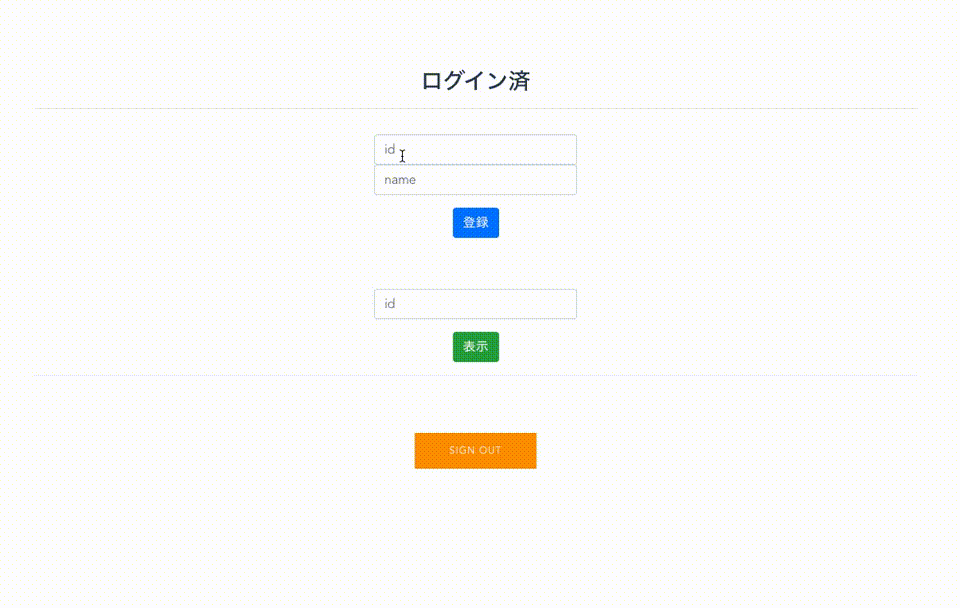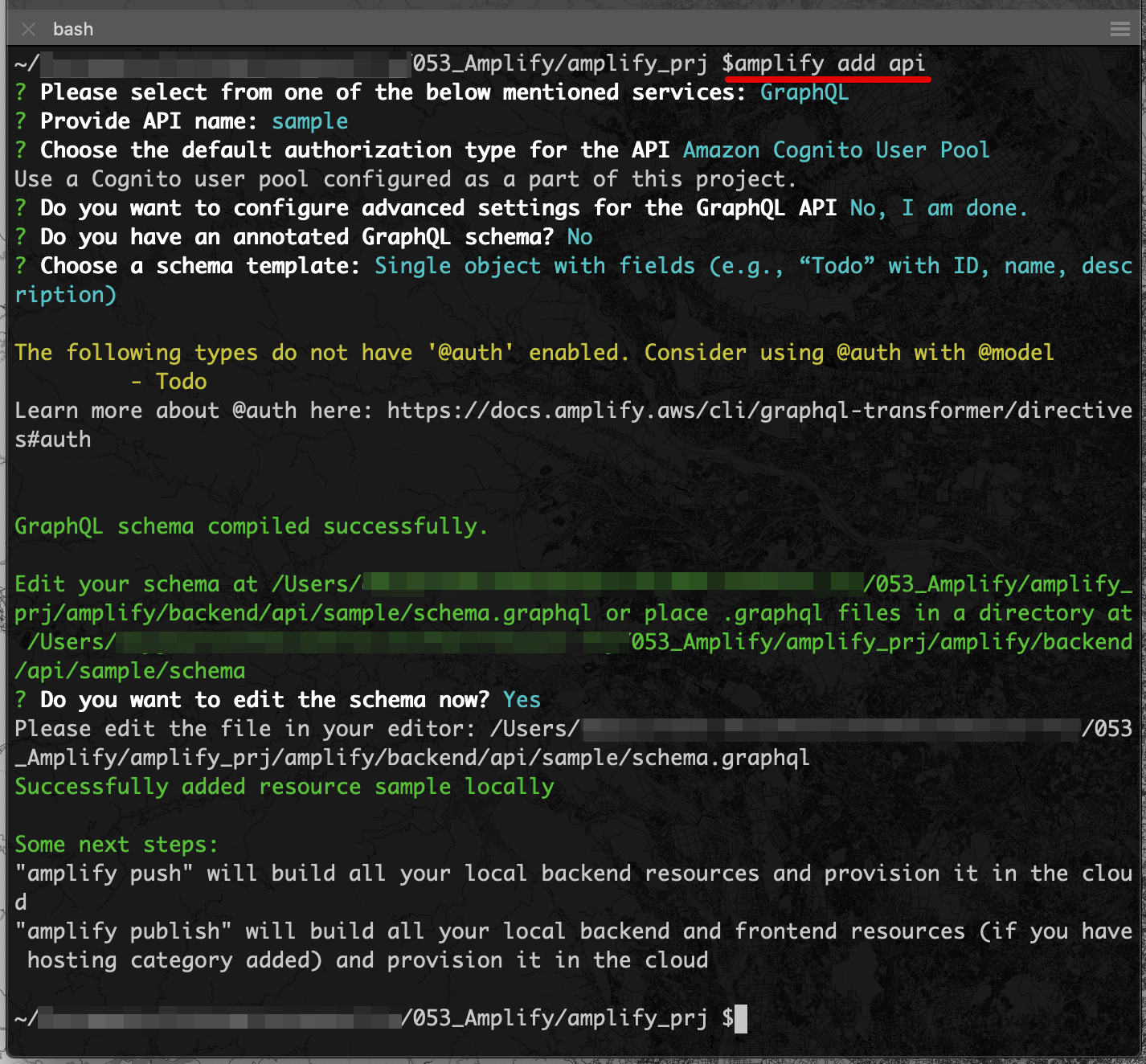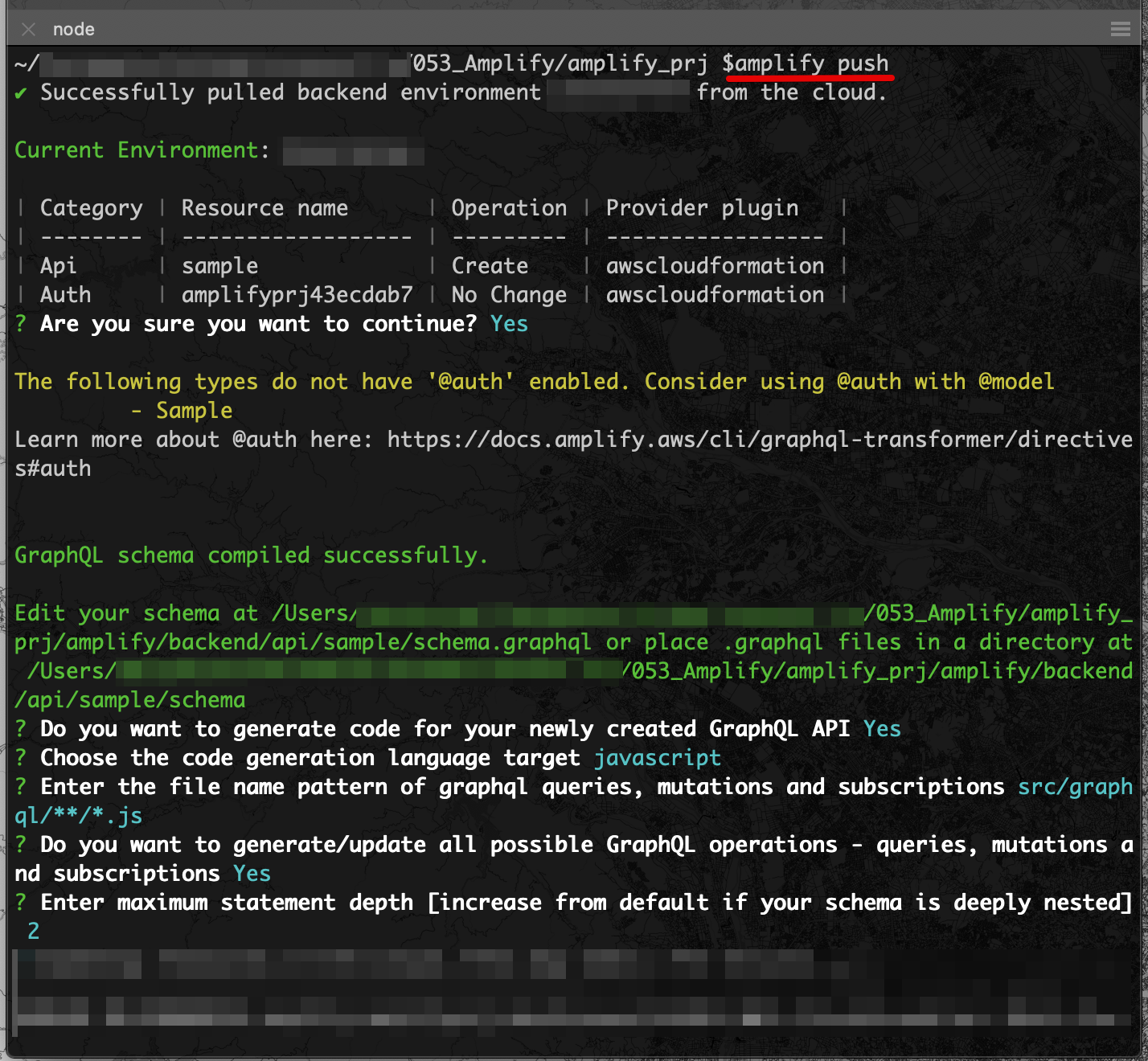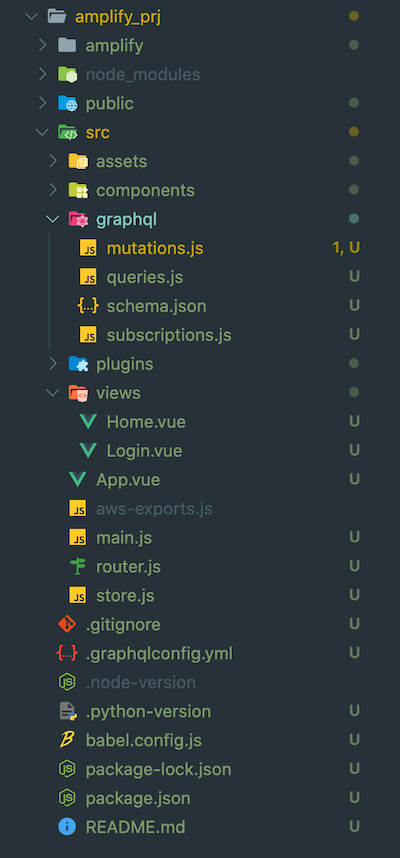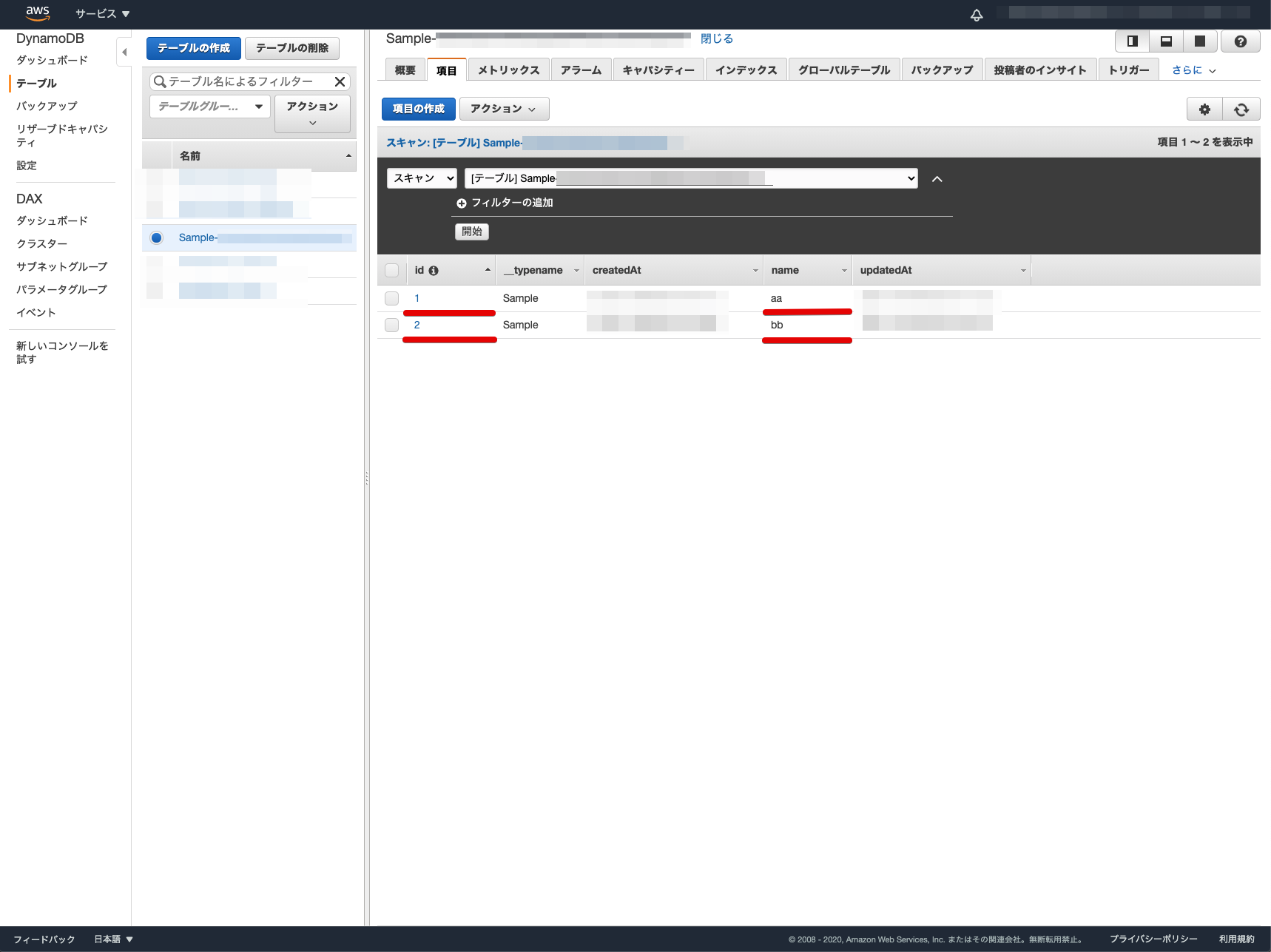この記事は、「AWS Amplify Advent Calendar 2020」の13日目の記事です。
AWS AmplifyとVue.jsでGraphQLのデータ登録取得機能を構築してみました 
事前準備
- AWS AmplifyとVue.jsのログイン機能までの設定
以前書いた記事からの続きで説明します。
AWS AmplifyとVue.jsでログイン機能を構築してみた
バックエンド
まずは、バックエンドを構築していきます。
以前の記事で、認証機能までを追加したので今回はAppSyncを利用したGraphQLの環境を設定します。
API機能のみであれば2コマンドで実装可能です!
amplify add api
API作成後、ひな形ができるのでスキーマをサンプル用に修正します。
../amplify/backend/api/sample
schema.graphql
type Sample @model {
id: ID!
name: String!
}
amplify push
処理が完了すると、APIの設定がほぼ自動で作成されているのが確認できます!
src/graphql
mutations.js
export const createSample = /* GraphQL */ `
mutation CreateSample(
$input: CreateSampleInput!
$condition: ModelSampleConditionInput
) {
createSample(input: $input, condition: $condition) {
id
name
createdAt
updatedAt
}
}
`;
export const updateSample = /* GraphQL */ `
mutation UpdateSample(
$input: UpdateSampleInput!
$condition: ModelSampleConditionInput
) {
updateSample(input: $input, condition: $condition) {
id
name
createdAt
updatedAt
}
}
`;
export const deleteSample = /* GraphQL */ `
mutation DeleteSample(
$input: DeleteSampleInput!
$condition: ModelSampleConditionInput
) {
deleteSample(input: $input, condition: $condition) {
id
name
createdAt
updatedAt
}
}
`;
src/graphql
queries.js
export const getSample = /* GraphQL */ `
query GetSample($id: ID!) {
getSample(id: $id) {
id
name
createdAt
updatedAt
}
}
`;
export const listSamples = /* GraphQL */ `
query ListSamples(
$filter: ModelSampleFilterInput
$limit: Int
$nextToken: String
) {
listSamples(filter: $filter, limit: $limit, nextToken: $nextToken) {
items {
id
name
createdAt
updatedAt
}
nextToken
}
}
`;
これだけでバックエンドの構築は完了になります ![]()
フロントエンド
次に、フロントエンドを構築していきます。
実行環境
- node v12.7.0
- npm v6.13.4
全体構成
package.json
{
"name": "amplify_prj",
"version": "0.1.0",
"private": true,
"scripts": {
"serve": "vue-cli-service serve",
"build": "vue-cli-service build",
"lint": "vue-cli-service lint"
},
"dependencies": {
"@aws-amplify/cli": "^4.37.1",
"aws-amplify": "^1.3.3",
"aws-amplify-vue": "^0.2.17",
"bootstrap-vue": "^2.0.0-rc.19",
"core-js": "^2.6.5",
"vue": "^2.6.10",
"vue-router": "^3.0.3",
"vuex": "^3.0.1"
},
"devDependencies": {
"@babel/polyfill": "^7.4.4",
"@vue/cli-plugin-babel": "^3.8.0",
"@vue/cli-plugin-eslint": "^3.8.0",
"@vue/cli-service": "^3.8.0",
"babel-eslint": "^10.0.1",
"bootstrap": "^4.3.1",
"eslint": "^5.16.0",
"eslint-plugin-vue": "^5.0.0",
"mutationobserver-shim": "^0.3.3",
"node-sass": "^4.12.0",
"popper.js": "^1.15.0",
"portal-vue": "^2.1.4",
"sass-loader": "^7.1.0",
"vue-cli-plugin-bootstrap-vue": "^0.4.0",
"vue-template-compiler": "^2.6.10"
},
"eslintConfig": {
"root": true,
"env": {
"node": true
},
"extends": [
"plugin:vue/essential",
"eslint:recommended"
],
"rules": {},
"parserOptions": {
"parser": "babel-eslint"
}
},
"postcss": {
"plugins": {
"autoprefixer": {}
}
},
"browserslist": [
"> 1%",
"last 2 versions"
]
}
src/views
Home.vue
<template>
<div class='home'>
<b-container>
<b-row>
<b-col sm='12' class='mb-3'>
<h3>ログイン済</h3>
<hr>
</b-col>
<b-col sm='3' class='mx-auto mb-3'>
<b-form-input v-model='id' placeholder='id'></b-form-input>
<b-form-input v-model='name' placeholder='name'></b-form-input>
</b-col>
<b-col sm='12' class='mb-5'>
<b-button variant='primary' v-on:click='postData'>登録</b-button>
</b-col>
<b-col sm='3' class='mx-auto mb-3'>
<b-table striped hover :items='items'></b-table>
<b-form-input v-model='text' placeholder='id'></b-form-input>
</b-col>
<b-col sm='12' class='mb-5'>
<b-button variant='success' v-on:click='getData'>表示</b-button>
<hr>
</b-col>
<b-col sm='12' class='mb-5'>
<!--ログアウトコンポーネント-->
<amplify-sign-out></amplify-sign-out>
</b-col>
</b-row>
</b-container>
</div>
</template>
<script>
// API機能読み込み
import { API, graphqlOperation } from 'aws-amplify'
import { createSample } from '../graphql/mutations'
import { getSample } from '../graphql/queries'
export default {
name: 'home',
components: {
},
data() {
return {
id: '',
name: '',
text: '',
items: []
}
},
methods: {
getData: async function () {
// データ取得
await API.graphql(graphqlOperation(getSample, {id: this.text}))
.then(response => {
// テーブル表示
this.items = [
{
id: response.data.getSample.id,
name: response.data.getSample.name
}
];
}).catch(error => {
// テーブルリセット
this.items = [];
});
},
postData: async function () {
// オプション
const myInit = {
id: Number(this.id),
name: String(this.name)
};
// データ登録
await API.graphql(graphqlOperation(createSample, {input: myInit}))
.then(response => {
console.log(response);
}).catch(error => {
console.log(error)
});
}
}
}
</script>
<style scoped>
</style>
AmplifyのAPI機能を読み込みます。
// API機能読み込み
import { API, graphqlOperation } from 'aws-amplify'
import { createSample } from '../graphql/mutations'
import { getSample } from '../graphql/queries'
データ取得用の関数を設定します。
getData: async function () {
// データ取得
await API.graphql(graphqlOperation(getSample, {id: this.text}))
.then(response => {
// テーブル表示
this.items = [
{
id: response.data.getSample.id,
name: response.data.getSample.name
}
];
}).catch(error => {
// テーブルリセット
this.items = [];
});
},
データ登録用の関数を設定します。
postData: async function () {
// オプション
const myInit = {
id: Number(this.id),
name: String(this.name)
};
// データ登録
await API.graphql(graphqlOperation(createSample, {input: myInit}))
.then(response => {
console.log(response);
}).catch(error => {
console.log(error)
});
}
簡易ローカルサーバーで確認してみます。
npm run serve
ローカルサーバーを立ち上げて、ログインしてみます。データの登録と取得ができるようになっています ![]()
AWSのコンソールでDynamoDBを選択し登録できているか確認してみます。
AWS AmplifyとVue.jsでGraphQLのデータ登録取得機能の構築ができました 
AmplifyでAppSyncを利用したGraphQLのAPIを構築して表示してみました。細かい設定はまだまだあったり、Amplifyの詳しい使い方を覚える必要はありますが、覚えてしまうと手軽にデータの登録取得機能も構築できるので、Firebaseと同じくサーバーレスアプリケーションを構築する時にとても便利です ![]()
以前のREST APIでの記事、「AWS AmplifyとVue.jsでデータ登録取得機能を構築してみた」とも比べてみて頂ければと思います ![]()
Vue.jsについて、他にも記事を書いています。よろしければぜひ ![]()
tags - Vue.js
やってみたシリーズ ![]()
tags - Try
